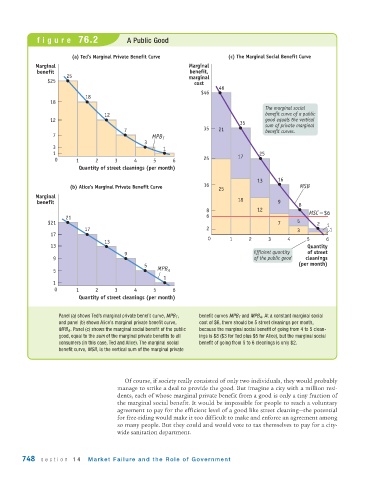Page 790 - Krugmans Economics for AP Text Book_Neat
P. 790
figure 76.2 A Public Good
(a) Ted’s Marginal Private Benefit Curve (c) The Marginal Social Benefit Curve
Marginal Marginal
benefit benefit,
25 marginal
$25
cost
46
$46
18
18
The marginal social
12 benefit curve of a public
12 good equals the vertical
35 sum of private marginal
7 35 21 benefit curves.
7 MPB T
3
3 1
1 17 25
0 1 2 3 4 5 6 25
Quantity of street cleanings (per month)
13 16
16
(b) Alice’s Marginal Private Benefit Curve 25 MSB
Marginal
benefit 18 9
8
8 12 MSC = $6
21 6
$21 7 5 2 1
17 2 3 1
17
0 1 2 3 4 5 6
13
13 Quantity
9 Efficient quantity of street
9 of the public good cleanings
5 (per month)
5 MPB A
1
1
0 1 2 3 4 5 6
Quantity of street cleanings (per month)
Panel (a) shows Ted’s marginal private benefit curve, MPB T , benefit curves MPB T and MPB A . At a constant marginal social
and panel (b) shows Alice’s marginal private benefit curve, cost of $6, there should be 5 street cleanings per month,
MPB A . Panel (c) shows the marginal social benefit of the public because the marginal social benefit of going from 4 to 5 clean-
good, equal to the sum of the marginal private benefits to all ings is $8 ($3 for Ted plus $5 for Alice), but the marginal social
consumers (in this case, Ted and Alice). The marginal social benefit of going from 5 to 6 cleanings is only $2.
benefit curve, MSB, is the vertical sum of the marginal private
Of course, if society really consisted of only two individuals, they would probably
manage to strike a deal to provide the good. But imagine a city with a million resi-
dents, each of whose marginal private benefit from a good is only a tiny fraction of
the marginal social benefit. It would be impossible for people to reach a voluntary
agreement to pay for the efficient level of a good like street cleaning—the potential
for free-riding would make it too difficult to make and enforce an agreement among
so many people. But they could and would vote to tax themselves to pay for a city-
wide sanitation department.
748 section 14 Market Failure and the Role of Gover nment

